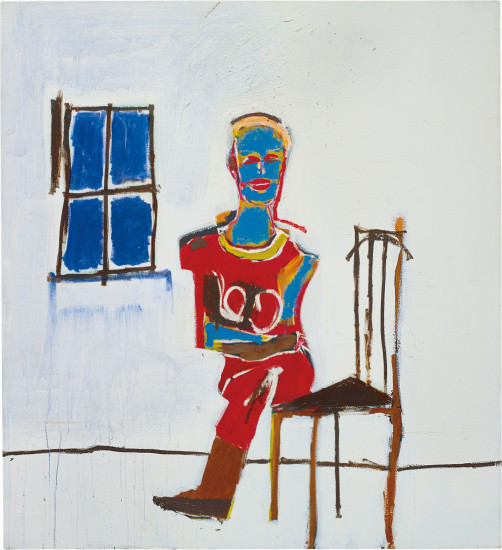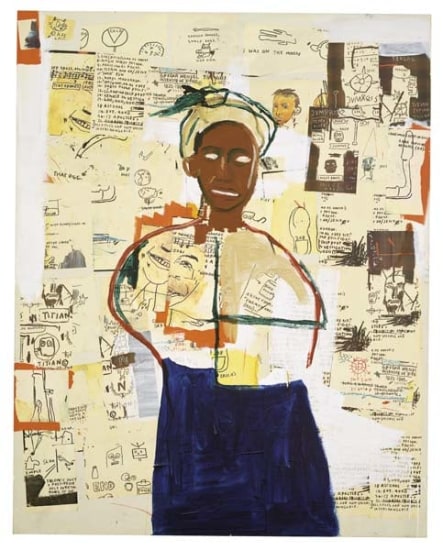Jean-Michel-Basquiat Cash Crop 1984 Oil and acrylic on canvas. 182.9 x 243.8 cm. (72 x 96 in). Signed, titled and dated 'Jean-Michel Basquiat Cash Crop 1984' on the reverse. This work is accompanied by a certificate of authenticity issued by the Authentication Committee of the Estate of Jean-Michel-Basquiat.
Provenance Larry Gagosian Gallery, New York; Private collection Exhibited Vienna, Kunsthaus, Jean-Michel-Basquiat, 1999 Literature Exhibition catalogue, Kunsthaus, Jean-Michel-Basquiat, Vienna, 1999, p. 87 (illustrated); E. Navarra, Jean-Michel-Basquiat, Paris, 2000, p. 214 (illustrated) Catalogue Essay The present lot, Cash Crop, a large scale and expressive canvas, was painted during the summer of 1984 during his first visit to the island of Maui in Hawaii, at a time when Basquiat was at the height of his fame and powers. Attracted by the island’s natural beauty and warm climate, Basquiat rented a secluded ranch in the tropical rain forest at Hana, and he would return there every summer until his untimely death in 1988. Hawaii became Basquiat’s paradise, an escape from the racism of the New York art world and from his heavy heroin addiction. On Maui, no one knew of his fame and wealth; he wandered the streets of the island barefoot and slept in one of the local’s fruit stands, an experience which must have taken him back to his teenage days when he was homeless and slept in cardboard boxes in Manhattan’s slums. In typical Basquiat style, Cash Crop is vigorously painted, executed with dynamic, powerful brushstrokes of intense raw colour. Its reddish brown foreground is indicative of Hawaii’s rich soil, its blue background of the clear skies and its golden yellow of the brilliant sun. Central to the composition are a sugar cane plant, the raw ingredient in the condiment which Basquiat has represented by writing the word SUGAR on a black box. Cash Crop poignantly examines an important theme that recurs throughout Basquiat’s oeuvre – the legacy of the colonial enterprise and his relationship to that legacy. From the late 15th century and Christopher Columbus’ first voyage to the Americas, sugar cane, abundant in Hawaii, was a cash crop for the white European colonizers, who used African slaves throughout the Caribbean to cultivate the crop. Jean-Michel-Basquiat, whose father was from Haiti, one the world’s largest producers of sugar during the Colonial era, empathized with the plight of the African slaves and commemorated their sacrifice in the present work. His endeavour and approach is reminiscent of the Mexican communist painter Diego Rivera whose famous murals of labourers Basquiat must have been aware of. In addition to Rivera, the late 19th-century French master Paul Gauguin also influenced Jean-Michel-Basquiat’s work, an influence clearly seen in Cash Crop. Like Basquiat, Gaugin escaped his native France for a distant tropical island, Tahiti, in order to purge himself of his artificial and conventional life. Like Basquiat in Hawaii, Gauguin lived as a local in Tahiti, where he sided with the natives in clashes with the French colonial government. Like Basquiat in Cash Crop, Gauguin painted the strikingly beautiful landscape of his adopted island using expansive areas of bold, saturated colour, a revolutionary painting style which would spur the Fauvist and Expressionist movements that, in turn, clearly influenced Basquiat. History will record both Gauguin and Basquiat as artists far ahead of their respective times both stylistically and thematically. Their extravagant lifestyles may have been somewhat mythified, but their brilliant and influential oeuvres are only too apparent, as are their sadly premature deaths – a lonesome man, Gauguin died of syphilis in jail. As with all tragic tales, the ending is heart wrenching and unfortunately Jean-Michel-Basquiat’s is no different. For those few years Hawaii was his safe haven, but it would also prove to be the beginning of his demise. It is said that in the summer of 1988, at the end of what would be his last stay on the island, Basquiat, while in the parking lot of Hana’s local store with a friend and his girlfriend, Kelle Inman, was confronted by a white man who repeatedly called him a “nigger”. An extremely upset Basquiat immediately broke down exclaiming “Not here. Not her
Jean-Michel-Basquiat Cash Crop 1984 Oil and acrylic on canvas. 182.9 x 243.8 cm. (72 x 96 in). Signed, titled and dated 'Jean-Michel Basquiat Cash Crop 1984' on the reverse. This work is accompanied by a certificate of authenticity issued by the Authentication Committee of the Estate of Jean-Michel-Basquiat.
Provenance Larry Gagosian Gallery, New York; Private collection Exhibited Vienna, Kunsthaus, Jean-Michel-Basquiat, 1999 Literature Exhibition catalogue, Kunsthaus, Jean-Michel-Basquiat, Vienna, 1999, p. 87 (illustrated); E. Navarra, Jean-Michel-Basquiat, Paris, 2000, p. 214 (illustrated) Catalogue Essay The present lot, Cash Crop, a large scale and expressive canvas, was painted during the summer of 1984 during his first visit to the island of Maui in Hawaii, at a time when Basquiat was at the height of his fame and powers. Attracted by the island’s natural beauty and warm climate, Basquiat rented a secluded ranch in the tropical rain forest at Hana, and he would return there every summer until his untimely death in 1988. Hawaii became Basquiat’s paradise, an escape from the racism of the New York art world and from his heavy heroin addiction. On Maui, no one knew of his fame and wealth; he wandered the streets of the island barefoot and slept in one of the local’s fruit stands, an experience which must have taken him back to his teenage days when he was homeless and slept in cardboard boxes in Manhattan’s slums. In typical Basquiat style, Cash Crop is vigorously painted, executed with dynamic, powerful brushstrokes of intense raw colour. Its reddish brown foreground is indicative of Hawaii’s rich soil, its blue background of the clear skies and its golden yellow of the brilliant sun. Central to the composition are a sugar cane plant, the raw ingredient in the condiment which Basquiat has represented by writing the word SUGAR on a black box. Cash Crop poignantly examines an important theme that recurs throughout Basquiat’s oeuvre – the legacy of the colonial enterprise and his relationship to that legacy. From the late 15th century and Christopher Columbus’ first voyage to the Americas, sugar cane, abundant in Hawaii, was a cash crop for the white European colonizers, who used African slaves throughout the Caribbean to cultivate the crop. Jean-Michel-Basquiat, whose father was from Haiti, one the world’s largest producers of sugar during the Colonial era, empathized with the plight of the African slaves and commemorated their sacrifice in the present work. His endeavour and approach is reminiscent of the Mexican communist painter Diego Rivera whose famous murals of labourers Basquiat must have been aware of. In addition to Rivera, the late 19th-century French master Paul Gauguin also influenced Jean-Michel-Basquiat’s work, an influence clearly seen in Cash Crop. Like Basquiat, Gaugin escaped his native France for a distant tropical island, Tahiti, in order to purge himself of his artificial and conventional life. Like Basquiat in Hawaii, Gauguin lived as a local in Tahiti, where he sided with the natives in clashes with the French colonial government. Like Basquiat in Cash Crop, Gauguin painted the strikingly beautiful landscape of his adopted island using expansive areas of bold, saturated colour, a revolutionary painting style which would spur the Fauvist and Expressionist movements that, in turn, clearly influenced Basquiat. History will record both Gauguin and Basquiat as artists far ahead of their respective times both stylistically and thematically. Their extravagant lifestyles may have been somewhat mythified, but their brilliant and influential oeuvres are only too apparent, as are their sadly premature deaths – a lonesome man, Gauguin died of syphilis in jail. As with all tragic tales, the ending is heart wrenching and unfortunately Jean-Michel-Basquiat’s is no different. For those few years Hawaii was his safe haven, but it would also prove to be the beginning of his demise. It is said that in the summer of 1988, at the end of what would be his last stay on the island, Basquiat, while in the parking lot of Hana’s local store with a friend and his girlfriend, Kelle Inman, was confronted by a white man who repeatedly called him a “nigger”. An extremely upset Basquiat immediately broke down exclaiming “Not here. Not her

.jpg)









Try LotSearch and its premium features for 7 days - without any costs!
Be notified automatically about new items in upcoming auctions.
Create an alert